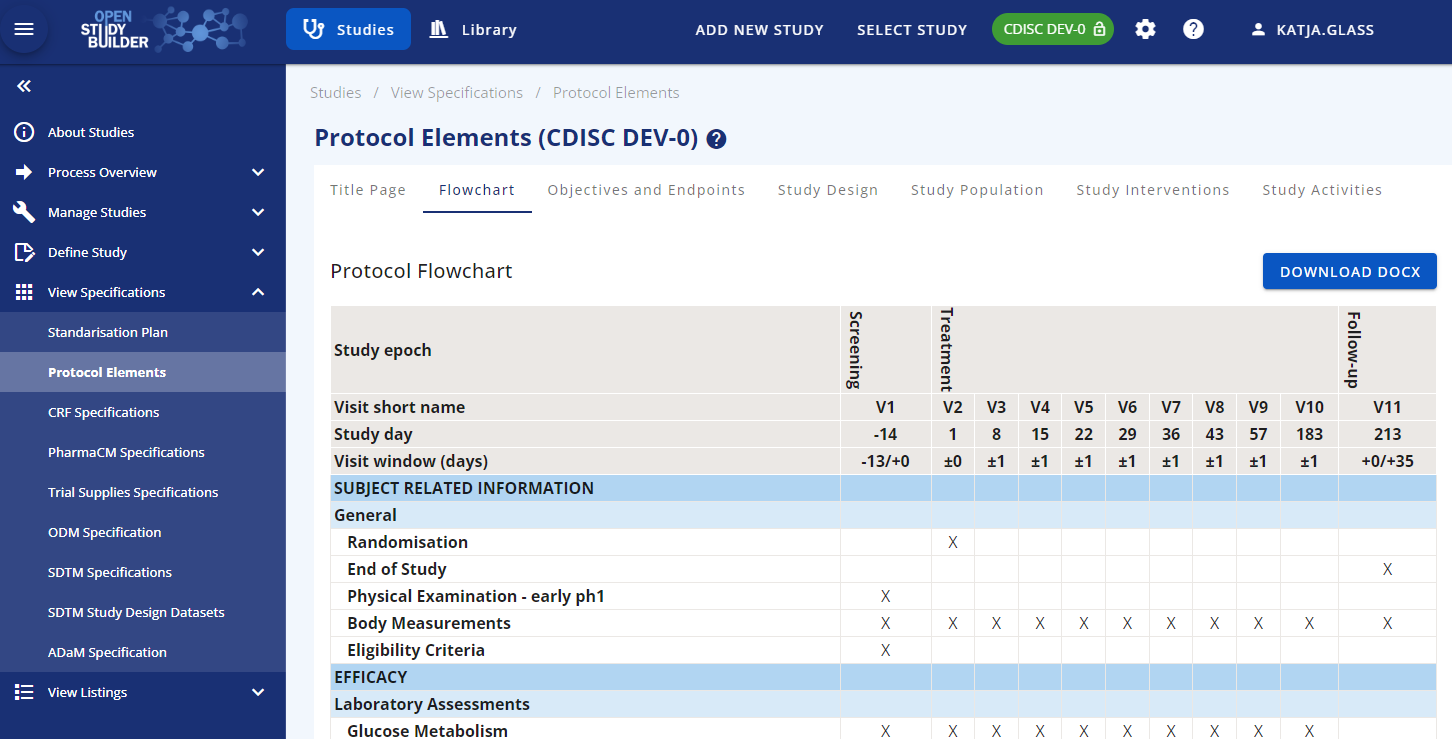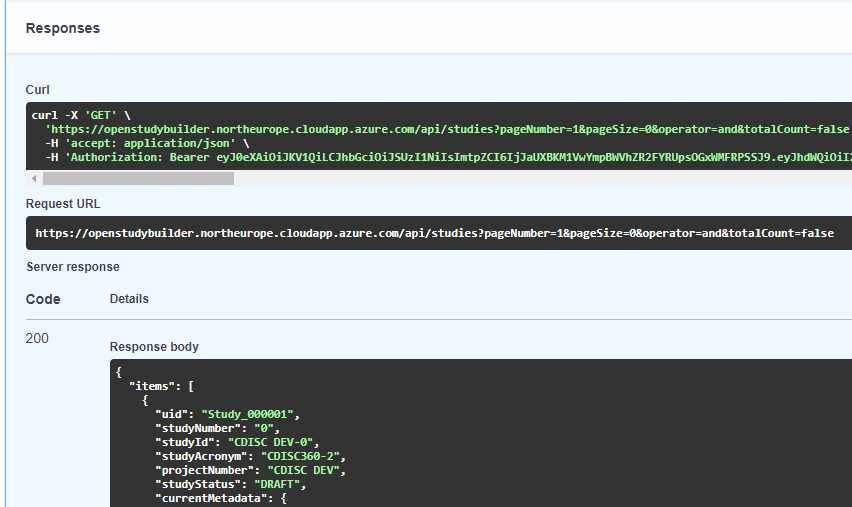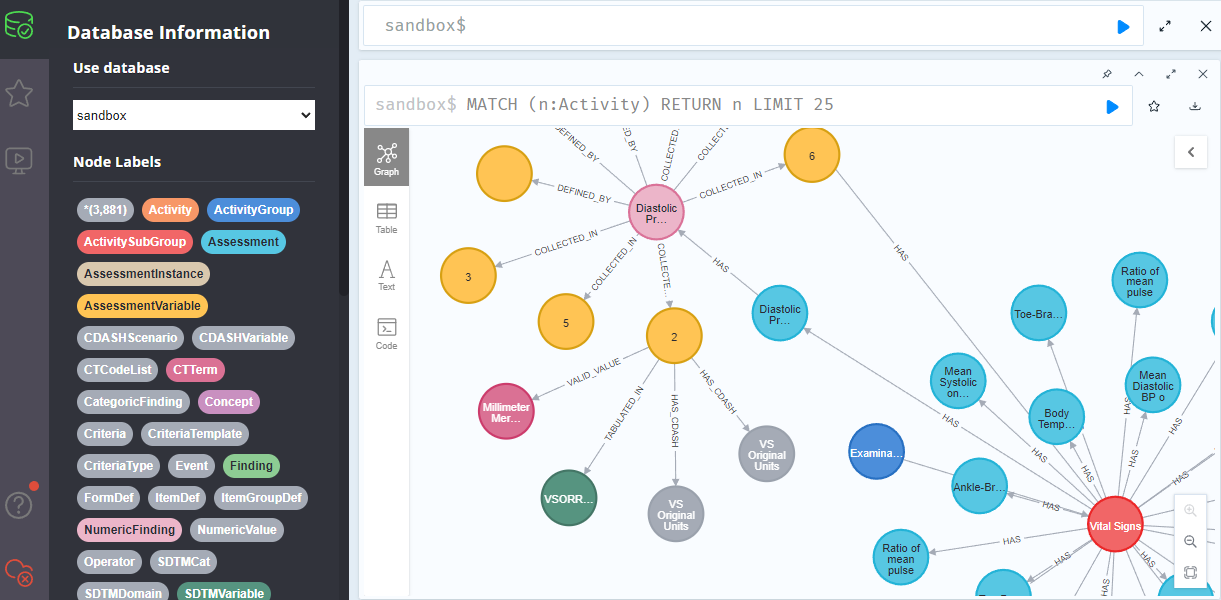Environments¶
(updated 2023-03-06 using v0.3)
There are various ways how you can access the OpenStudyBuilder solution as a running application. The following options are documented:
- Sandbox system (no own installation required)
- Lokal docker installation
- Azure deployment
Sandbox environment¶
The OpenStudyBuilder project offers a fully featured sandbox environment, allowing users to explore and experiment with the open-source solution no installation required. This environment is ideal for gaining hands-on experience with both the metadata repository (MDR) and the study definition repository (SDR) content part.
The sandbox includes a user-friendly web application, a powerful API for programmatic access, comprehensive tool documentation, and database tools such as NeoDash dashboards. Additionally, it provides a graph browser and Bloom for querying and visualizing the underlying graph data model and database content.
Overview¶
The following tools and URLs are available after registration
| Tool | URL | Note |
|---|---|---|
| OpenStudyBuilder Application | https://openstudybuilder.northeurope.cloudapp.azure.com/ | main application |
| Documentation | https://openstudybuilder.northeurope.cloudapp.azure.com/doc/ | product related documentation |
| API | https://openstudybuilder.northeurope.cloudapp.azure.com/api/docs | API documentation and running API calls |
| NeoDash | https://openstudybuilder.northeurope.cloudapp.azure.com/neodash/ | Dashboard for underlying database |
| DB Browser | https://openstudybuilder.northeurope.cloudapp.azure.com/browser/ | Browser for underlying database |
| Bloom | https://openstudybuilder.northeurope.cloudapp.azure.com/bloom/ | Graph broswer for underlying database |
Getting Access¶
The public sandbox provides a convenient way for anyone to explore and test OpenStudyBuilder without the need to install any software. To request access to the sandbox environment, simply send an email to openstudybuilder@neotechnology.com (Request Sandbox Access).
Please be aware that the sandbox is refreshed periodically, which means any data you create will be lost after a refresh. Additionally, all data in the sandbox is publicly accessible to anyone with sandbox access. For transparency and traceability, all data entries are tracked with the user's email address and are visible to everyone using the sandbox. Therefore, please avoid entering any sensitive or confidential information. The sandbox is intended for evaluation and learning purposes only.
The Application¶
The core application can easily be started with a browser. The sandbox system has already an example study which can be loaded, browsed and changed. Under the "Define Study" all relevant study protocol and trial domain information can be managed. The "View Specifications" section is available to use the entered information in different formats, e.g. for the protocol.

The general and sponsor standards can be maintained in the "Library" part of the application. Next to the functionality to browse standards like the controlled terminology from CDISC, also sponsored preferred names can be stored alongside. Extensible codelists can be added by elements and additional new sponsor codelists like for different visits can be created. Dictionaries can be maintained and browsed as well.
A core feature of the MDR and the underlying graph data model are the concepts. Standard activities can be grouped and linked. Even unit mapping for UCUM, CT and sponsor units can be maintained. The "Syntax Templates" are a fantastic feature which allows to use generic texts for protocols with semantic meaning.

The Documentation¶
The tool documentation is available via the sandbox as well. This even does not need any authentication as it's a simple webpage which can be accessed here. Next to a user guide, you also find useful information about the architecture.
The API¶
A main advantage of the OpenStudyBuilder is the openness for interfaces. The API is very powerful. Everything what the application does uses APIs which updates the graph database. This means that everything can be automated via scripts. Data can easily be loaded via the API. All the data and standards data is loaded into the solution via import scripts (mdr-standard-imports and data-imports). These can be adopted to import other data.
All information available can also be exported via API and then used by other tools. When you browse the API Swagger documentation, you can see and execute various API endpoints available.

The Graph Database / Biomedical Concept¶
The heart of the application is the graph database which is using Neo4j. It contains a biomedical concept linking all kind of data which allows a high level of connectivity for automations. The NeoDash can be used to browse the concepts.

Next to NeoDash there is also the DB Browser. This can be used to browse the Neo4j database directly using the query language Cypher. After logging in via SSO (in case of issues clear cache or do a hard reload of the page), you can select the sandbox database. You can either use a direct query or get along by selecting a node and follow the connections.

Finally, Bloom is also available which allows to create and store Scenes. This is very valuable if you want to come back to a visualization or share this with others. In one of our next newsletters, we are going to have a closer look into the concepts.
Logins¶
Application
The core application is accessible through https://openstudybuilder.northeurope.cloudapp.azure.com/. You need to register with your Microsoft account which is using the mail you had been used for registration. Click the "Login" button and use your Microsoft credentials and include also the security code which is mailed to you.
You can then browse studies or the library by selecting the corresponding icons in the top-bar.
Documentation Portal
The documentation is stored here: https://openstudybuilder.northeurope.cloudapp.azure.com/doc/. This contains a lot of documentation and easily browsable. This does not require any authentification.
Neo Dashboard
Via https://openstudybuilder.northeurope.cloudapp.azure.com/neodash/, the Dashboard can be used. Use the "SSO" sign in. If this is not available, then there are cookie issues. Please refresh the webpage by using no "cache", for example in Chrome you can use Ctrl + Shift and click R.
Database Browser
Via https://openstudybuilder.northeurope.cloudapp.azure.com/browser/, the Neo4j database can be browsed, e.g. by using Cypher for queries. You need to select single sign on (SSO) and then the browser will start. If the SSO is not available, then there are cookie issues. Please refresh the webpage by using no "cache", for example in Chrome you can use Ctrl + Shift and click R.
Bloom
Finally, https://openstudybuilder.northeurope.cloudapp.azure.com/bloom/ is available to access the bloom tool. You have to select SSO for login here as well. If the SSO is not available, then there are cookie issues. Please refresh the webpage by using no "cache", for example in Chrome you can use Ctrl + Shift and click R.
Lokal docker installation¶
You can install the OpenStudyBuilder with or without test data locally. The easiest way is to use the docker instructions. For this you just need to follow the instructions on the readme files. You can also install the single components by following the instructions in the corresponding readme files within each sub-folder.
The current version 0.4 installation does include already test data and is very convenient to install. For Windows for example, make sure that you meet all pre-requisites that docker is running on the command line. Then you just need the following commands to setup, install and startup the OpenStudyBuilder:
cd c:\myInstallLocation
git clone https://github.com/NovoNordisk-OpenSource/openstudybuilder-solution.git OpenStudyBuilder
cd OpenStudyBuilder
docker compose up -d --build
You can also checkout the readme files in the subfolders to install individual components. If you also want to load additional CDISC terminology, you can follow along the "mdr-standards-import" readme. You might not want to load all CTs at once, but load just those you need.
Overview¶
On the local docker installation, the following tools are available. If you have not changed the port numbers, the tools will be available via the following links:
| Tool | URL | Note |
|---|---|---|
| OpenStudyBuilder App | http://localhost:5005/ | main application |
| Documentation | http://localhost:5005/doc/ | product related documentation |
| API | http://localhost:5005/api/docs | API documentation and running API calls |
| Consumer API | http://localhost:5005/consumer-api/docs | API documentation and running API calls for consumer API |
| Dashboards | http://localhost:5005/neodash/ | Browser available NeoDash dashboards |
| DB Browser | http://localhost:5001/browser/ | Browser for underlying database |
Azure Deployment¶
You can also use the following instructions for an azure deployment. Please note that this setup is not using any security.
az login
az account set --subscription <name or id>
az group create --name myOpenStudyBuilderResourceGroup --location westeurope
az acr create --resource-group myOpenStudyBuilderResourceGroup --name myuniqueownacrname --sku Basic
az acr login --name myuniqueownacrname
git clone https://github.com/NovoNordisk-OpenSource/openstudybuilder-solution.git
cd OpenStudyBuilder-Solution
Then you have to update some configurations, add the following to docker-compose.yml:
- Line 7 -> image: myuniqueownacrname.azurecr.io/database
- Line 29 -> image: myuniqueownacrname.azurecr.io/api
- Line 56 -> image: myuniqueownacrname.azurecr.io/frontend
- Line 68 -> image: myuniqueownacrname.azurecr.io/documentation
Furhtermore replace in frontendfiles/default.conf:
- proxy_pass http://api:5003/; -> proxy_pass http://localhost:5003/;
- proxy_pass http://documentation:5006/; -> proxy_pass http://localhost:5006/;
Then finally create and deploy the solution:
docker compose build
docker compose push
az acr repository show --name myuniqueownacrname --repository database
az acr update --resource-group myOpenStudyBuilderResourceGroup --name myuniqueownacrname --admin-enabled true
az deployment group create --resource-group myOpenStudyBuilderResourceGroup --template-file openstudybuilder-template.json --parameters containerImageRegistryServer=myuniqueownacrname.azurecr.io containerImageRegistryUser=myuniqueownacrname
When prompted enter you access key to Azure container registry. Now the solution could be started using your Azure URL: http://#URL#:5005/.